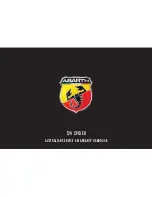
50
Due to the above specific features of the fuel supply system design, the following is recommended:
-
When closing the filler necks of fuel tanks, make sure that the plugs are in good order and that the gasket is present
and intact, and ensure that the plugs close tightly by applying appropriate force;
-
If the vehicle is partially refueled, first fill the left-hand tank;
-
control the fuel consumption taking into account the change in the amount of fuel in both tanks.
Fuel tanks.
Maintenance of the fuel tanks includes periodic flushing of the electric fuel pump (left tank), flushing of
filter of the fuel gauge receiver pipe (right tank) and flushing of the tanks.
Drain the sludge periodically.
Periodically check the reliability of the tank mounting and, if necessary, tighten their mounting bolts.
Remove the fuel tank from the vehicle for flushing.
It is possible to flush the electric fuel pump filter without removing the fuel tank. The electric fuel pump module is
removed through a hatch in the floor of the body.
Electric fuel pump.
Periodically check and clean the contacts connecting the fuel pump to the on-board network.
Pay special attention to the reliability of the "ground" connection.
It is not recommended to run the vehicle with less than 5 liters of fuel in the left fuel tank.
When coming steep rises, the minimum fuel amount in the left tank shall be at least 20 liters.
Clogging of the mesh filter of the fuel module and fuel fine filter, the presence of dirt and mechanical
impurities in the fuel tank are manifested primarily in the deterioration of fuel pumpability from the right tank to
the left tank, unstable operation of the engine under heavy loads a
nd the deterioration of the vehicle’s dynamics.
With these symptoms, one shall immediately visit the service station to avoid the electric fuel pump failure.
The following work must be done at the service station:
-
disconnect the fuel inlet and outlet pipes;
-
remove the left fuel tank;
-
remove the immersion-type module:
-
flush the fuel tank with clean gasoline and dry it (e.g., wipe it with a lint-free wipe);
-
remove the collection cup of the electric fuel pump and flush it;
-
wash the mesh filter (
do not remove the mesh filter from the electric fuel pump, as this will result in
voidance of the manufacturer's warranty)
);
-
install the electric fuel pump in the fuel tank (pay attention to the installation of the o-ring, which must be dried);
If after the above measures the character of engine
operation has not changed, i.e. unstable engine operation is observed, then
it is necessary:
1. Replace fine fuel filter.
2. Make sure there is fuel in the main fuel tank. Minimum quantity is 10 liters (for tests only).
3. Measure the pressure in the supply system (on the engine running at idle):
а)
at 800 rpm and at 2000...2500 rpm (should be approximately 2.6...2.7 kgf/cm
2
);
b) when the throttle is opened abruptly for a short time (there should be a rise up to 3.0 kgf/cm
2
);
c) when the ignition is on and the engine is not running - 3.0...3.15 kgf/cm
2
.
4. Check the jet pump nozzle for opening cleanliness.
5. Check the connection of the right fuel tank to the atmosphere, the main line from the engine (pressure regulator) to
the left tank must not be pinched.
6. Determine fuel flow rate at the fuel rail drain (it must be at least 75 L/h at back pressure of 300
-10
kPa and supply
voltage (13.5±0.1)V). Conduct of measurements through the fuel drain hose by disconnecting it from the jet pump.
If the fuel does not drain or drains less than 75 L/h, the electric fuel pump must be replaced.
Note.
When the ambient temperature is below 0 ° C, signs of clogging may be due to the presence of water and its
freezing in the fuel system. If water is found in the fuel, drain the fuel and flush the fuel tank with clean gasoline, and
replace the fine fuel filter.
Jet pump.
Periodically check the pump and its connections for leaks. If fuel is pumped from the auxiliary tank to the
main tank, disassemble the pump (unscrew the jet nozzle), flush it and purge it with air.
The jet pump is fixed to the fuel hoses at the frame rail.
Leaks in the connections
are remedied by tightening the connections (see annex 2) or by replacing defective
elements.
After any maintenance of the fuel supply system associated
with tightening the connections, removal or
replacement of parts and components, it is necessary to check the tightness of the system:
-
make sure the filler plugs are securely tightened;
-
tighten the clamps and threaded joints until they are tight;
-
start the engine and inspect the system when idling. Dribbling of fuel or moistening of elements of the fuel supply
system is not allowed.
The throttle actuator
may require adjustment of the cable tension during operation. For cable tensioning, unscrew
nut 3 (Fig. 9.8) and tighten nut 4.
Содержание UAZ-374195
Страница 10: ...10 Fig 1 7 Outline averaged dimensions of the UAZ 390995 with gross weight dimensions are given for reference...
Страница 14: ...14 Fig 1 11 Outline averaged dimensions of the UAZ 330365 with gross weight dimensions are given for reference...
Страница 15: ...15 Fig 1 12 Outline averaged dimensions of the UAZ 390945 with gross weight dimensions are given for reference...
Страница 88: ...88 Annex 5 85 UAZ CONNECT TELEMATICS SERVICES 85...
Страница 89: ...Intentionally Left Blank...
















































